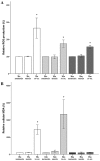Cell Death Patterns Due to Warm Ischemia or Reperfusion in Renal Tubular Epithelial Cells Originating from Human, Mouse, or the Native Hibernator Hamster
- PMID: 30445750
- PMCID: PMC6316155
- DOI: 10.3390/biology7040048
Cell Death Patterns Due to Warm Ischemia or Reperfusion in Renal Tubular Epithelial Cells Originating from Human, Mouse, or the Native Hibernator Hamster
Abstract
Ischemia⁻reperfusion injury contributes to the pathogenesis of many diseases, with acute kidney injury included. Hibernating mammals survive prolonged bouts of deep torpor with a dramatic drop in blood pressure, heart, and breathing rates, interspersed with short periods of arousal and, consequently, ischemia⁻reperfusion injury. Clarifying the differences under warm anoxia or reoxygenation between human cells and cells from a native hibernator may reveal interventions for rendering human cells resistant to ischemia⁻reperfusion injury. Human and hamster renal proximal tubular epithelial cells (RPTECs) were cultured under warm anoxia or reoxygenation. Mouse RPTECs were used as a phylogenetic control for hamster cells. Cell death was assessed by both cell imaging and lactate dehydrogenase (LDH) release assay, apoptosis by cleaved caspase-3, autophagy by microtubule-associated protein 1-light chain 3 B II (LC3B-II) to LC3B-I ratio, necroptosis by phosphorylated mixed-lineage kinase domain-like pseudokinase, reactive oxygen species (ROS) fluorometrically, and lipid peroxidation, the end-point of ferroptosis, by malondialdehyde. Human cells died after short periods of warm anoxia or reoxygenation, whereas hamster cells were extremely resistant. In human cells, apoptosis contributed to cell death under both anoxia and reoxygenation. Although under reoxygenation, ROS increased in both human and hamster RPTECs, lipid peroxidation-induced cell death was detected only in human cells. Autophagy was observed only in human cells under both conditions. Necroptosis was not detected in any of the evaluated cells. Clarifying the ways that are responsible for hamster RPTECs escaping from apoptosis and lipid peroxidation-induced cell death may reveal interventions for preventing ischemia⁻reperfusion-induced acute kidney injury in humans.
Keywords: apoptosis; autophagy; ferroptosis; hibernation; ischemia–reperfusion; lipid peroxidation; necroptosis.
Conflict of interest statement
The authors declare no conflict of interest.
Figures






References
LinkOut - more resources
Full Text Sources
Research Materials

